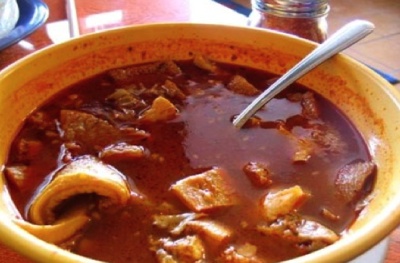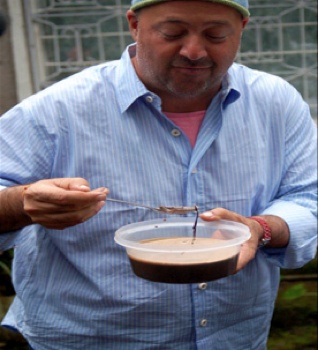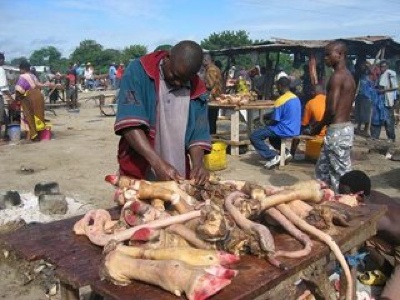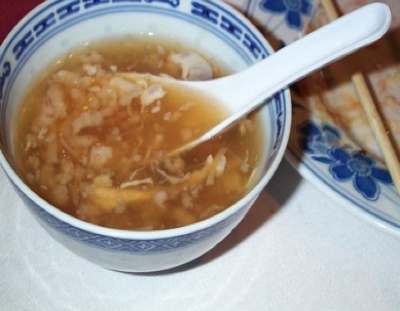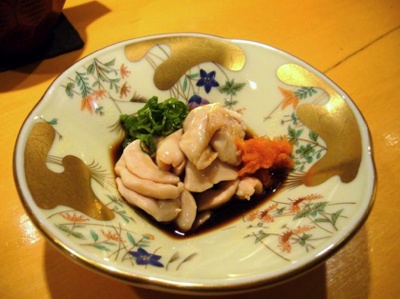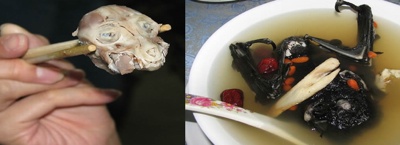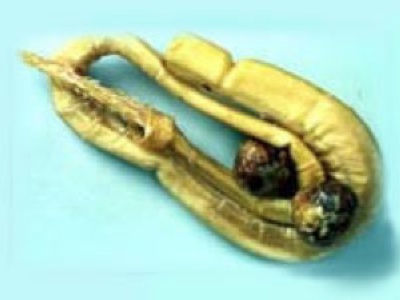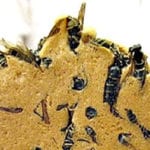This is a personal favorite and while it is not very bizarre where I come from, some may find cow stomach soup to be a little odd. Menudo is a traditional Mexican soup that is very popular and often made for special occasions. It is also widely known as a cure all for hangovers. Menudo consists of tripe or cow stomach, onions, cilantro, oregano, chilis and hominy. It takes anywhere from seven to ten hours to make, as the meat needs to cook for an extended time to make it tender. Some people wonder how stomach lining can be delicious but when you add all of the other ingredients and let it simmer for hours what you get is an insanely good soup. The tripe is so tender it almost melts in your mouth, add some corn tortillas for dipping and you got yourself a meal. Who knew cow stomach could be so good? The origin of Menudo varies, found throughout Mexico, the soup most likely came from a need to use every part of the cow, in this case stomach lining. You can find the soup in most Mexican restaurants.
Perhaps the simplest soup on the list comes to us from the Chagga tribe that lives at the base of Mount Kilimanjaro. The tribe depends on agriculture for their livelihood focusing on bananas and coffee. A no frills type of life gets you a no frills soup, made of sweet bananas, beans and dirt or “earth” as they call it. Essentially the ingredients are all mixed together to form the soup including bits of twigs that can be seen in the picture. The dirt supposedly gives the soup a saltiness and earthiness flavor.
This soup reminds me a little of Menudo, with many parts of the animal being used to create a flavorful soup or stew. Supu simply means soup, but the breakfast version of this Tanzanian soup is the most extravagant, made from goat lungs, heart, liver, head, cow stomach, intestines and tongue. If you are lucky, you might even get a cow hoof and tail thrown in. The hooves are sometimes boiled and is called supu ya makongoro. The soup eaten for breakfast is a traditional dish in Tanzania and is also widely known to cure hangovers.
Very similar to our traditional chicken noodle soup except that it has chicken testicles instead of chicken meat. The soup simply made from testicles and vegetables is cooked in broth until tender. The testicles are creamy on the inside and very soft, similar to tofu but with tight skin like a sausage. Others have compared it to an under cooked egg with a custard consistency. Again, the testicles are said to have good side effects, in this case good skin for the women and stamina for the men. I have always heard that kind of stuff is good for your skin. There are black and white chicken testicles available for soups.
One of the most expensive soups on the list, Bird Nest Soup is made from the nests of Swiftlet birds. The Chinese soup is a delicacy, and sells for as much as $30 to $100 per bowl, a kilogram of the nest can cost up to $2000. Soups made from nests are almost entirely from the birds own sticky saliva. The nest dissolves and becomes gelatinous with water. The bird’s nests have been in Chinese cooking for centuries usually in the soup. Swiftlet birds make their nests in caves by the male and take over 35 days to build. The cup shaped nests are interwoven strands of salivary cement. Some common health benefits that are associated with the soup are, focus, improved asthma, libido, and the immune system.
In Shanghai, China, you can have Deer Placenta Soup that will help you in bed, your kidneys, skin and vitality. I am starting to see a trend here. The soup is made from mushrooms, flowers, black chicken (must be where the black testicles come from) and deer tendon in a broth. While the soup actually sounds good, the placenta is elastic making it chewy when eating it. If you do not know exactly what a placenta is, here is the definition to make it even more appetizing. The sac-shaped organ that attaches the embryo or fetus to the uterus during pregnancy in most mammals. Blood flows between mother and fetus through the placenta, supplying oxygen and nutrients to the fetus and carrying away fetal waste products. The placenta is expelled after birth.
Known as Cods Milk Soup stateside and Shirako in Japan, the soup is essentially the sperm sac of male codfish. Shirako is served raw or in a soup. The sperm sac cooks until it melts down into chowder like broth becoming creamy, almost like custard. Shirako, appropriately means “white children” and is available in the winter. As with many animal parts in Asian cuisine that have special qualities, eating the Cod’s sperm gives you stamina in bed. There is a restaurant in New York that serves the dish as a specialty.
This next soup would not be so bad if they would at least take the fuzzy fur off the bat. In the islands of Palau, this soup is again a delicacy in town. Although I am starting to think many of these “delicacies” came from unknowing tourists willing to try anything. The island has two types of bats, the insect eating and the large fruit bats. The latter are cooked in coconut milk, ginger, spices and boiled for several hours. At some restaurants, the customer is able to choose his or her bat before cooking it alive in boiling water. Many people who have tried the soup stated it is delicious, although having a furry rodent like head staring at you can be unsettling.
There are many penis soups out there but this is by far one of the most rare and expensive. Tiger Penis Soup has been around for centuries in Asian cultures, known for its almost mythical properties akin to Viagra. The dried tiger penis is soaked in water for a week and then simmered up to 24 hours with other spices and medicines, at times with tiger bone. A single bowl of soup can cost you up to $400. Tigers are an endangered species and protected, yet many Asian markets still carry tiger parts in their shops. A recent survey of New York’s Chinatown revealed that 60% of the shops claimed to carry tiger parts. If you do decide to buy some tiger penis make sure it is legit, shady shop owners often substitute ox or deer tendons for the real thing.
Finally, we have a soup so bizarre it can hardly be called a soup at all. It is a traditional soup in Vietnamese cuisine made from simple ingredients, raw blood (usually duck), cooked gizzards, and topped with peanuts and herbs. The soup is refrigerated so the blood coagulates and can then be eaten chilled before the blood loses its jello like consistency. Supposedly, the soup gives both the person making and eating it strength. Its popularity has declined since the bird flu spread through Asia. Although many still eat it, there is concern for the public’s health in consuming raw blood from ducks. Did I really have to tell you that though?
Soup #5 has been added as a bonus for the sake of completion. Strong like a bull is a phrase that attracts some lovers to this four-legged mammal with a notorious temper. In areas of Southeast Asia, a soup (known as soup # 5) composed of onions, carrots, broth and bull’s penis and testicles is a popular dish noted for its aphrodisiac properties. The parts in question are given a good scrubbing and scalded in boiling water for good measure before winding up in an aromatic soup loaded with vegetables. Unlike some truly wild aphrodisiacs that are potentially harmful, bull’s soup is pretty tame by any stretch of the imagination. And while ostrich testicles are said to be tasty, they fall short in the bedroom when compared to the hardy bull variety.
